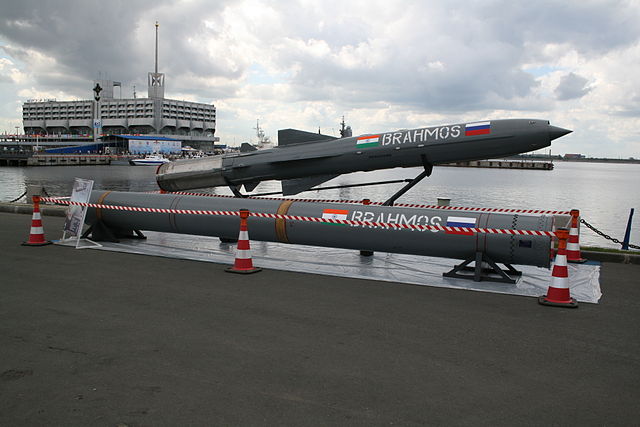In August 2016, Government of India decided to deploy 4th regiment of BrahMos Missile in our North-Eastern state – Arunachal Pradesh. CCS’s (Cabinet Committee on Security) approved the request of raising a new regiment of an advanced version of BrahMos missiles to be deployed in Arunachal Pradesh at a cost of Rs. 4300 crore. The regiment will be equipped with five autonomous missile launchers with command post. It would include 100 BrahMos missiles.
But this deployment has caused a lot of anxiety and nervousness in our northern neighbouring country. Few days after the news of BrahMos deployment in Arunachal Pradesh came out, China’s People’s Liberation Army (PLA) declared it a threat to China and the boundary dispute. They went onto say that “missile with updated capabilities for stealth and mountain warfare could threaten Yunnan and Tibet Autonomous Region (TAR) provinces, located across the border from Arunachal Pradesh.”
In an article in the mouthpiece of China’s armed forces, military naval engineer Cheng Yuyi declared India’s move as “beyond India’s `normal need for self-defence`. Playing tricks, they are bound to suffer the consequences.” Though he acknowledged in the article that the deployment can’t pose a great threat as it has a limited range of 290 KM and cannot hit any target in mainland China.
But then why China is making so much of fuss over this small step? After all, the range of the missile is just 290 KM and it can carry a warhead of just 200/300 KG.
Looks like Dragon is nervous. Brief introduction of the missile will help us understand – why.
BrahMos is a state of the art, highly advanced, supersonic one of its kind missile in the world. This short-range ramjet supersonic cruise missile was developed under a joint project of India & Russia that started in the late 1990s.
During the cold war, instead of a conventional subsonic cruise missile, USSR developed an unconventional Supersonic cruise missile that can evade American aircraft carriers’ defensive setup & destroy it. It is important to note here that USSR never undertook the development of aircraft carriers seriously. (Towards the end of cold war, four Kiev Class carriers were built – one of which was Admiral Gorshkov, which is now in service with Indian Navy.) To tackle American threat from aircraft carriers’, USSR successfully developed supersonic anti-ship cruise missiles, that could evade American carriers’ missile defence systems and destroy it.
The aim of BrahMos project was to develop an Indian version of P-800 Oniks anti-ship missile. (Initially BrahMos was developed as Anti-Ship missile for Navy but later its success and abilities moved Indian Armed Forces to push `BrahMos Aerospace` to develop a land-based and air-launched version of the missile.) In a theoretical study, 16 ripple fired BrahMos missiles can take out US Navy’s most advanced Arleigh Burke class destroyer.
Unlike other cruise missiles like Tomahawk (of the USA) & Babar (of Pakistan) that fly at a sub-sonic speed of 500-600 KMPH, BrahMos can touch an astonishing maximum speed of Mach 2.8 (roughly 3400 KMPH). Though its range is limited – just 290 KM and it can carry a light warhead of just 200-300KG, its ability to maintain supersonic speeds while skimming at low altitude makes it very difficult to detect and intercept. During the last leg of its flight, just before hitting its target, BrahMos performs `S-manoeuvre’ to evade any anti-missile defence system.
BrahMos’ kinetic energy gives it an edge in terms of stealth, hit probability and better target penetration characteristics, making it a deadly weapon. One can only imagine the impact a target would have when a 3 ton 28 feet long missile carrying a300 KG semi-armor-piercing warhead flying at speed of 3000 KMPH hit it with pinpoint accuracy (CEP of 5 meters) – missile will tear the ship apart.
BrahMos was first tested in June 2001 and later was deployed successfully on Rajput class destroyers. In 2004, land attack version from mobile launchers was tested for Army and it completed the testing in 2009 to completed satisfaction of the end user. Since then 3 regiments have been commissioned and deployed. The 4th regiment will have the a latest version of a missile that was specially designed for mountain warfare. It was first tested in April 2014 in a steep dive-cum-target discrimination mode, that enables the missile to take out selected targets hidden behind a mountain range accurately. This is what is bothering the Dragon.
China knows that India has no territorial designs. India is ensuring that its armed forces have the necessary equipment and infrastructure available to thwart any Chinese aggression. In any short swift war such deadly, accurate and stealth weapons will be of immense value to destroy Chinese command & control centres, firepower centres, Radar and Air Defence sites etc. This would change the course of the conflict. Though China is acquiring one of the best missile defence systems S400 from Russia but BrahMos’ very small RCS (Radar cross section), supersonic speed coupled with S-manoeuvre and low flying altitude makes it extremely difficult to track & intercept. The only possible Anti-missile system that can possibly stop BrahMos (single or ripple fired) effectively is Barak-8.
An Air Launched version of the BrahMos (named BrahMos-A) is also being developed. BrahMos-A will be 500KG lighter than its Army and Naval versions. It will weigh 2.5 ton and will carry a warhead of 300 KG. First demonstration flight of Su-30 MKI carrying BrahMos-A was conducted on 25th June 2016. Su-30 MKI had to undergo structural modification and its undercarriage had to be strengthened. IAF will equip 40 Su-30 MKIs with BrahMos & has already deployed Su-30 MKI Squadrons near China border in north-eastern part of India. Equipping Su-30 MKI with BrahMos-A will allow IAF to deliver the deadliest punch with a CEP of 5 meters deep inside Tibet and Chinese province-Yunnan.
All frontline warships of Indian Navy have already equipped with one or two 8-cell UVLM for BrahMos block I & II missiles. Navy has already been doing long patrols and with the signing of Logistics Exchange Memorandum of Agreement (LEOMA) with the USA, it will give access to both IAF and Navy to US overseas naval bases. Though the LEOMA is for few specific reasons like joint military exercises, training, port calls, humanitarian missions and other military activities that both sides mutually agree to undertake (and every access request made by one country will be accessed and approved/rejected by other country beforehand. This agreement does not facilitate easy and unlimited access to each other’s bases). But the Dragon will not rule out the possibility where these bases could give necessary logistic support to Indian vessels or fighters to carry out an operation against Chinese mainland. After-all desperate times call for desperate measures.
The present Indian government has demonstrated clarity about India’s objectives in every field and is bold enough to call a spade a spade. Since 2006, half-hearted decisions were taken to equip armed forces to counter Chinese threat but now this process is on the fast track. Earlier we were just looking at the Chinese `String of Pearls` encircling us but now India is turning the table on Chinese. For last 50 years, China has been supporting and equipping Pakistani armed forces with various weapon platforms. China also helped Pakistan with Strategic weapons and missile development. It provided nuclear weapon designs to Dr. AQ Khan and facilitated missile designs from North Korea (in lieu of nuclear technology, CIA provided photos showing PAF’s C-130 delivering the hardware at a North Korean airbase). Thus helped Pakistan getting both the weapon and the delivery system. China has been closely working with other countries like Sri Lanka, Myanmar, Maldives etc to gain port access there. That is how the term `String of Pearls` came into existence.
Now this string is getting reversed with India ready to sell BrahMos missile to Vietnam & Philippines, with whom China has a dispute over the South China Sea. The possible sale of BrahMos to these countries have already created ripples in China. As per Chinatopix1 – `The People’s Liberation Army Navy (PLAN) has no defense against India’s BrahMos supersonic cruise missile — the fastest anti-ship missile in the world — and India is intent on selling these world-beating missiles to both Vietnam and the Philippines…..The surface-to-air missiles on PLAN warships such as the FL-3000N will be almost useless against a volley of supersonic BrahMos hurtling towards a Chinese warship at Mach 3. The current generation of PLAN ship-borne SAMs can only effectively engage anti-ship missiles travelling at half the speed of BrahMos. `
A future customer of both naval and air force version of the missile would be Japan and Taiwan. A hypersonic version of BrahMos (flying at 6000 KMPH) is already being developed and should be ready in 5-7 years. Keeping BrahMos Aerospace’s track record, the deadline of 5-7 years looks realistic. They have always delivered on time.
In a nutshell, Dragon has real reasons to worry about.






This is indeed a very detailed information on India defence Missile BrahMos especially, on china Hue & cry.
Keep writing … Thanks
Amit kumar
This article is full of jargons and complete misunderstanding of military technology. Take for example the statement:
“its ability to maintain supersonic speeds while skimming at low altitude makes it very difficult to detect”
From signal processing aspect, the higher supersonic speed will result in larger Doppler shift in the receiver spectrum analyser than for the lower subsonic case, and hence will be no more difficult for detection ability, if not an easier case. In fact, it could result a better resolution for eliminating multi-path noise from reflections of any search radar beam by peaks in mountainous region. There are other ignorant claims such as “USSR developed an unconventional Supersonic cruise missile that can evade American aircraft carriers’ defensive setup & destroy it.”
Read more at:
https://www.indiandefencereview.com/news/brahmos-missile-in-north-eastern-state-is-dragon-nervous/#comment-526942
Dear sumit
Your articles always make us feel proud of our Armed forces and the agencies supporting them.
We mango people hardly understand nor we ever try either to delve into such topics.
Thanks for you eye opener articles
Nice Article Sumit.
What a written article buddy
This has really increased by knowledge towards our defense system. You are really good in explaining the situation we are going through in our country. I personally believe that you have keep the same pace never stop writing. You article are full of information which even some core people don’t know. I really blessed to have a colleague who can help me understand the current affair. Bravo buddy 🙂
Brilliant article Sumit!
Many Indians still doesnt know about our defence strengths & achievements, we always think other countries are strong with latest defence equipment. No doubt there are still many things which India has to buy or build to match with other countries including infrastructure along the borders and to protect ourselves especially from CHINA & Pakistan.
Anyways, as I always say please dont stop writing, keep it going and you are good at this. We always there for your support.
Good job dear.
China is also deploying forces and building highways on ladakh border. Are we taking same kind of steps on ladakh border?
Interesting article! Keep up the good work 🙂
Mr. Walia if BrahMos is so capable then why the Russians are not using it, in fact none of the 3 wings of Russian armed forces are using it ?
Mr Lather, Russia does not need Brahmos. They have P800 which has larger range and speed is little less that Brahmos. Thats is why this project was to develop an Indian varient of P800.
P-800 is an outdated missile, even Vietnam imported it from Russia, still they want BrahMos from India; what does that mean. On the other hand, I would say that things continues to get worst for Russian after dangerous NATO military build-up in Eastern Europe. Therefore, Russia needs BrahMos missile very badly, still they are not using it in any of their wings, its quite surprising.
Nobody actually knows that why the Russians are hesitating in inducting BrahMOS.
Mr Lather, P800 development started in around 1983 nad was first deployed in 2002. by 1998 when Brahmos project was setup, development of P800 was already over. Thats why P800 is mother missile of Brahmos. Not sure, how it can be considered as outdated.
When Russian deplyed P-800 in 2002, they re-considered their intent of buying Brahmos. When the project was setup, Russia and India both were to buy it.
Vietnam is importing Brahmos means nothing special. Because (i) every country select weapon system based on their requirement an various other factors and (ii) they ordered Coastal based missile varient of P-800 and just 2 units. They are interested in Naval version of Brahmos.
Unlike the MMS govt., Modi is PROACTIVE with Nation’s Security and rightly so.